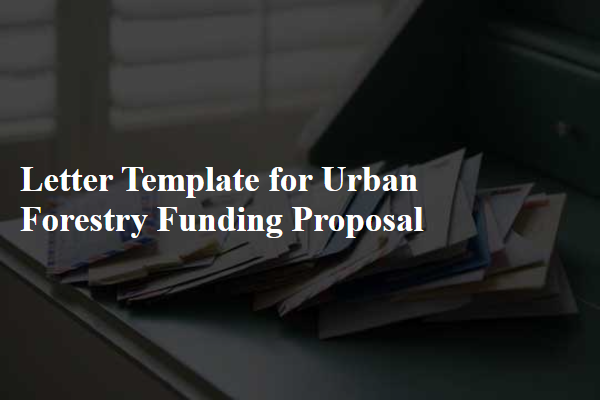Are you passionate about enhancing our urban landscapes and combating climate change? Our cities are bustling with life, yet they often lack the greenery that supports our well-being and the environment. In this article, we'll explore the critical role of urban forestry in creating sustainable urban environments, along with a compelling funding proposal template that can help you secure the resources needed for your green initiatives. Dive in to learn how you can make a difference and elevate your community's tree canopy!

Project Overview and Objectives
Urban forestry initiatives, aimed at enhancing green spaces within metropolitan environments, contribute significantly to urban ecosystems. This proposal seeks funding for a project in Charlotte, North Carolina, targeting the planting and maintenance of 1,000 native trees over a two-year period in both residential and public areas. Objectives include improving air quality, reducing urban heat island effects, and increasing carbon sequestration by approximately 300 tons annually. Community engagement programs will educate residents on the importance of urban trees in biodiversity and urban planning. Additionally, partnerships with local environmental organizations will ensure project sustainability, while data collection will assess the ecological impact and community involvement, fostering long-term environmental stewardship.
Detailed Budget Allocation
A comprehensive budget allocation is crucial for the success of urban forestry projects aimed at enhancing green spaces in cities. Funds are typically categorized into distinct areas: tree procurement, which may account for 40% of the total budget, involves purchasing native species such as Oak or Maple, with an average cost of $200 per tree; planting and installation, estimated at 30%, covers labor and equipment rental, often costing around $25 per hour; maintenance, approximately 20%, includes watering, mulching, and pruning services, typically budgeted at $15,000 annually; and community engagement activities, allocated around 10% of the budget, such as workshops and volunteer days, fostering public involvement and education. Effective monitoring and evaluation strategies should also be integrated, with a small percentage reserved for assessing the long-term impact on urban biodiversity and air quality improvements, highlighting the multifaceted benefits of investing in urban forestry initiatives.
Community Impact and Engagement
Urban forestry initiatives play a crucial role in enhancing community well-being and environmental sustainability in urban areas like New York City and Los Angeles. Green spaces, such as community parks (over 1,500 accessible public parks nationwide), contribute to improved air quality, reducing urban heat by up to 15 degrees Fahrenheit in certain neighborhoods. Engaging local residents through volunteer tree-planting events fosters a sense of ownership and pride, with studies indicating that volunteer participation can increase community cohesion by 30%. Educational workshops on tree care, designed for diverse age groups, can enhance knowledge about biodiversity and urban ecology. Collaborations with schools (approximately 70% of urban schools in the U.S. have green programs) can integrate environmental education within curricula, reaching thousands of students annually. Ultimately, a robust urban forestry program not only beautifies the city landscape but also promotes health, equity, and a sustainable future for all residents.
Environmental Benefits and Sustainability
Urban forestry programs provide significant environmental benefits and promote sustainability within metropolitan areas. Trees, such as oaks and maples, improve air quality by absorbing pollutants, storing carbon dioxide, and producing oxygen, contributing to healthier urban atmospheres. The presence of urban forests can lower surface temperatures (up to 10 degrees Fahrenheit) through shade and evapotranspiration, mitigating the urban heat island effect often experienced in cities like Los Angeles or New York City. Additionally, urban trees play a crucial role in stormwater management, reducing runoff by up to 50%, which minimizes flooding and improves water quality in local waterways. Biodiversity is enhanced through the provision of habitat for various species, including birds and pollinators, fostering ecological resilience. Investing in urban forestry programs creates sustainable green spaces, supports community health, and enhances overall urban livability.
Partner Organizations and Stakeholder Support
Engaging with local communities and organizations fosters a collaborative approach to urban forestry initiatives. Notable partners like the City of Springfield Parks Department and the Springfield Community Garden Network have expressed strong support, highlighting the importance of green spaces. Involvement from stakeholders such as the Urban Tree Canopy Alliance and the Springfield Eco-Friends Group adds credibility and diverse expertise to the project. Additionally, support from local businesses like GreenLeaf Nursery, which offers plant donations, enhances resource availability. These partnerships aim to increase tree planting efforts, enhance community engagement, and improve overall urban biodiversity, ultimately creating a sustainable environment in Springfield while addressing urban heat island effects and improving air quality.
Letter Template For Urban Forestry Funding Proposal Samples
Letter template of urban forestry funding request for community enhancement.

Letter template of urban forestry funding proposal for ecological restoration.

Letter template of urban forestry funding application for educational programs.

Letter template of urban forestry funding inquiry for public health benefits.

Letter template of urban forestry funding bid for climate change mitigation.

Letter template of urban forestry funding proposal for biodiversity promotion.

Letter template of urban forestry funding appeal for recreational space improvement.

Letter template of urban forestry funding request for economic development initiatives.

Letter template of urban forestry funding proposal for community engagement projects.





Comments